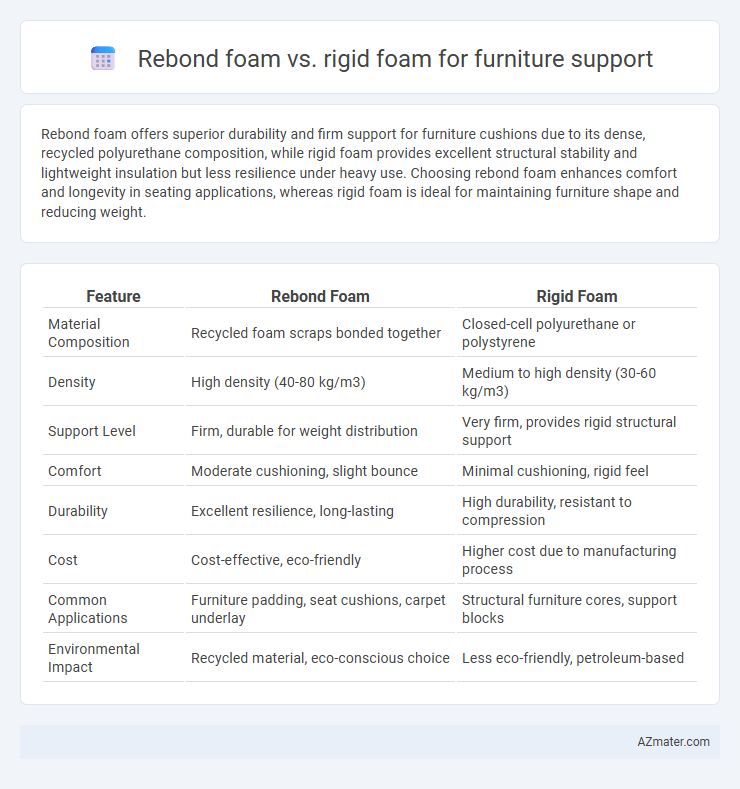Rebond foam offers superior durability and firm support for furniture cushions due to its dense, recycled polyurethane composition, while rigid foam provides excellent structural stability and lightweight insulation but less resilience under heavy use. Choosing rebond foam enhances comfort and longevity in seating applications, whereas rigid foam is ideal for maintaining furniture shape and reducing weight.
Table of Comparison
| Feature | Rebond Foam | Rigid Foam |
|---|---|---|
| Material Composition | Recycled foam scraps bonded together | Closed-cell polyurethane or polystyrene |
| Density | High density (40-80 kg/m3) | Medium to high density (30-60 kg/m3) |
| Support Level | Firm, durable for weight distribution | Very firm, provides rigid structural support |
| Comfort | Moderate cushioning, slight bounce | Minimal cushioning, rigid feel |
| Durability | Excellent resilience, long-lasting | High durability, resistant to compression |
| Cost | Cost-effective, eco-friendly | Higher cost due to manufacturing process |
| Common Applications | Furniture padding, seat cushions, carpet underlay | Structural furniture cores, support blocks |
| Environmental Impact | Recycled material, eco-conscious choice | Less eco-friendly, petroleum-based |
Introduction to Foam Types in Furniture Support
Rebond foam consists of shredded foam pieces bonded together, offering high durability and firm support ideal for heavy-use furniture cushions. Rigid foam, known for its dense and stiff structure, provides superior shape retention and stability, commonly used for structural support in furniture frames. Choosing between rebond and rigid foam depends on the desired balance of comfort, resilience, and strength in furniture applications.
What is Rebond Foam?
Rebond foam is a durable, high-density material made by bonding shredded foam scraps together using adhesive and heat, creating a resilient support core ideal for furniture applications such as cushions and padding. Unlike rigid foam, which is solid and inflexible, rebond foam offers superior cushioning and shock absorption due to its compressed, multi-layered construction. Its ability to maintain shape and provide consistent support makes rebond foam a preferred choice for heavy-use furniture where comfort and durability are critical.
What is Rigid Foam?
Rigid foam, a dense and durable material made from polyurethane or polystyrene, provides exceptional support and stability in furniture construction. It offers high compressive strength and resistance to deformation, making it ideal for load-bearing applications such as seat cushions and structural padding. Unlike rebond foam, rigid foam maintains its shape over time, ensuring long-lasting firmness and durability in furniture support systems.
Key Differences Between Rebond and Rigid Foam
Rebond foam, created from recycled foam scraps bonded together, offers superior density and durability, making it ideal for heavy-duty furniture support where long-lasting comfort and resilience are crucial. Rigid foam, typically made from polyurethane or polystyrene, provides excellent compressive strength and insulation but lacks the flexibility and cushioning properties of rebond foam. Key differences include rebond foam's enhanced cushioning capacity and eco-friendly composition versus rigid foam's structural firmness and thermal resistance, influencing their applications in furniture design.
Durability and Longevity Comparison
Rebond foam offers superior durability in furniture support due to its dense structure made from recycled foam scraps bonded together, providing excellent resilience and shape retention over time. Rigid foam, while lightweight and moisture-resistant, tends to compress and degrade faster under continuous pressure, reducing its longevity in high-use furniture applications. Choosing rebond foam ensures extended furniture lifespan with consistent support, making it preferable for long-term durability versus rigid foam.
Comfort and Support Analysis
Rebond foam offers superior cushioning and pressure distribution, making it ideal for enhanced comfort in furniture support, while rigid foam provides firmer structural support and durability. The elasticity of rebond foam absorbs impact and conforms to body contours, reducing discomfort over prolonged use. Rigid foam's high density maintains shape integrity, offering consistent support but less adaptability to individual body shapes.
Application Suitability: Where Each Foam Excels
Rebond foam offers excellent durability and superior resilience, making it ideal for high-traffic furniture like sofas and chairs that require long-lasting support and comfort. Rigid foam provides firm, structural reinforcement often used in furniture frames or as a stable base layer, ensuring shape retention and enhanced stability. Selecting between rebond and rigid foam depends on whether cushioning comfort or foundational support is the primary requirement in the furniture application.
Cost Comparison: Rebond vs Rigid Foam
Rebond foam offers a cost-effective solution for furniture support due to its manufacturing process from recycled foam scraps, significantly reducing material expenses compared to rigid foam. Rigid foam, although providing superior structural integrity and durability, generally commands a higher price point because of its closed-cell composition and specialized production. Choosing rebond foam balances affordability and adequate support, while rigid foam suits applications where long-term resilience justifies the increased investment.
Environmental Impact and Sustainability
Rebond foam, made from recycled foam scraps, significantly reduces landfill waste and promotes circular economy practices, making it a more sustainable choice compared to rigid foam, which often relies on non-renewable petroleum-based materials. The production of rigid foam involves higher energy consumption and releases greenhouse gases, contributing to environmental concerns such as ozone depletion and fossil fuel depletion. Rebond foam's durability and recyclability further enhance its environmental benefits, supporting eco-friendly furniture manufacturing and waste reduction efforts.
Which Foam is Best for Your Furniture Needs?
Rebond foam offers superior durability and firm support, making it ideal for high-traffic furniture like sofas and chairs that require long-lasting cushioning. Rigid foam provides excellent structural integrity and insulation but can be too stiff for comfort-focused seating applications. Choosing between rebond and rigid foam depends on whether your priority is enhanced comfort and resilience or rigid support and shape retention in furniture design.

Infographic: Rebond foam vs Rigid foam for Furniture support
 azmater.com
azmater.com